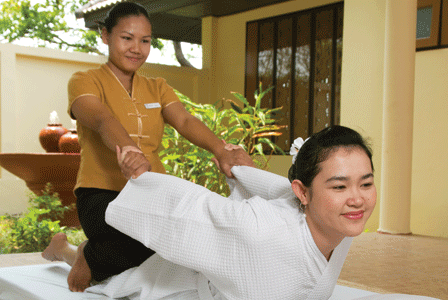
Thai yoga massage is a dynamic form of body work based on the principes of yoga and Ayurvedic medicine. Learn how it can benefit your health
Thai massage, or Thai yoga massage as it is referred to in the West, is a dynamic form of body work based on the principles of yoga and Ayurvedic medicine. It is often called “lazy man’s yoga” because of the yoga-like poses into which the practitioner guides the client’s body.
The stretching performed during a Thai yoga session is rhythmic, almost dance-like, and requires the client to expend no energy. You simply lie on the mat while the practitioner dynamically guides your body using his or her own body weight, legs, and arms to enhance the stretch.
The Zen of sen
Thai yoga massage is performed one- on-one and can last anywhere from 60 minutes to two and a half hours. Unlike traditional massage, Thai yoga massage requires the client to be fully clothed, wearing loose and comfortable clothing, while lying on a thin mat on the floor.
The practitioner kneads (or “palms”) the muscles, applying acupressure by “thumbing” 10 major energy lines on the body, and then places the client in a variety of stretches where they are positioned supine, prone, seated, or on the side.
The energy lines (called sen lines) are the foundation of Thai massage and originate from the Eastern understanding that invisible energy lines run throughout the body, almost like a second skin. A blockage in any of these lines of energy can cause problems not only physically but also spiritually, emotionally, and mentally. Through the use of palming and thumbing, the practitioner can open up any blockages and allow the energy to flow freely once again.
Finding a Thai master
Most practitioners of Thai yoga massage learn from the masters in Thailand and spend years perfecting the art of Thai massage. A few schools can now be found in North America; there are also a number of entrepreneurial individual practitioners setting up beginner to advanced training programs at local recreation centres, yoga studios, and other spaces.
Currently, no formal certification is needed to become a Thai yoga massage therapist, so it is buyer beware.
To find a reputable Thai yoga massage therapist in your area, I recommend asking friends and colleagues. Once you have found one, ask the therapist what sort of training he or she has had and how long he or she has been practising. Ideally, the practitioner should have completed at least an 80-hour program and have 15 to 20 massages under their belt.
This therapeutic method offers the best stretch I have ever experienced. That’s what turned me into a believer of Thai yoga massage.
Benefits of Thai yoga massage
- Increased range of motion and flexibility
- Reduced stress
- Reduced pain
- Reduced swelling
- Increased blood circulation
- Increased lymphatic circulation
- Facilitated removal of toxins
- Increased energy flow

